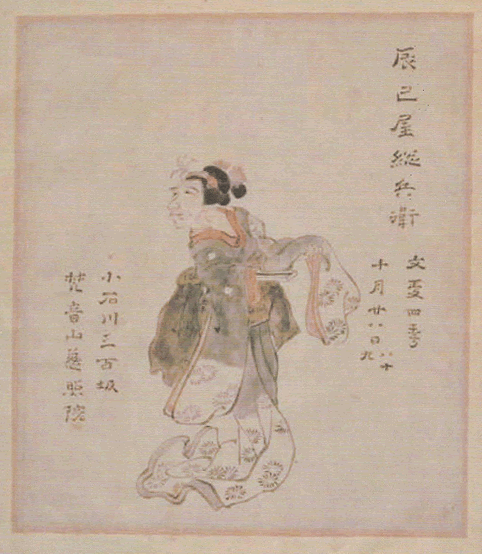
|

|
|

|
 
|
|
|
|
|

|

|

Tatsumiya Sobe born 1733, whose real name was Hirai Tatsugiri, was the founder of Tatsumi-ryu. He ran two small restaurants in front of Fukujuin Temple in Edo Koishikawa.
He was fond of dancing and he spent a most of his free time practicing dance.
What made him popular though was a funny sight of his dancing in a women's costume.
In 1788 he created a new style of dancing called "kyogen shinraku", for the general public, which departed from traditional theater dancing.
He became quite famous for his dancing and he was invited to not only shrine festival but also daimyo's (Japanese feudal lord) residence for entertainment.
At those times, it is said that he danced not for money but just for entertainment and he never accepted rewards.
He was recognized as a famous choreographer in the periods of Horeki,
Kansei, Bunka and Bunsei of Edo era.
During this period, the choreographer Fujima Kanbei II arranged "Ninin
wankyu" and Fujima Kanjuro arranged "Yasuna" and "Fujimusume", which
were also popular. However the dancing arranged by Tatsymiya Sobe
rised in popularity among the general public.
From 1783 to 1787, there was a large famine in Japan, which cast a
huge shadow over the land. People were trying very hard to recover
from that.
Edo was the city where the shogun lived, and the Kanda festival of
Kanda myojin was one of the most famous festivals in Japan. The festival
was for praying for an abundant harvest and the peace of the country.
Not only the Shogun but also his heir, wife, retainers, lords and
maids participated in the festival.
It would be spectacular to see that festival of floats and paraders
marching into the castle. Following the parade, selected amature dancers
of city girls danced in gorgeous costume.
Among the dancers, Tatsumiya Sobe danced costumed as a girl. The
people loved his sense of humour and bright dancing style.
Tatsumiya Sobe died at the age of 89 on Oct 28th in 1821. The People
of Edo felt great sorrow at his passing and mourned at his funeral
parade by dancing. His dancing figure in a girl's costume is carved
on a grave stone at Jishoin temple in Koishika. Ohota Shokusanjin,
a writer of the Edo era familiar with Sobe, described the look as
'Omatsuri to Kagura no do ni Tatsumiya no Kareki-musume ya Hanasakaji
(If Tatsumiya is at festivals or Noh farce dancing, that indeed is
very spectacular.)
It can be said that Japanese traditional culture developed through
the dancing culture of this period. Sobe's aim was that everyone
can have fun and learn dancing easily. This make people happy and
healthy. We can imagine that the people of Edo loved Sobe's dancing
and enjoyed dancing together. It is unfortunate that Tatsumiya didn't
go beyond the 2nd head.
|

|
|